
The Triple Solo Sailor blog commemorates the 30th anniversary of Jon Sanders' triple solo circumnavigation of the world with log book information, photos and film footage created by Sanders himself. See the Triple Solo Sailor blog or Twitter for more information.
Jon Sanders began his voyage from Fremantle on 25 May 1986 with the aim of circumnavigating the world three times, on his own, with no stopping and no reprovisioning. His first circumnavigation would be west-about, and the second and third circumnavigations would be east-about with the voyage planned to finish in Sydney. 38
The Launch
'This is the high adventure point. I'm going because I want to. Some people might call me crazy. That doesn't worry me one bit. Anyway, if I am crazy that might be a bit of a help' - Jon Sanders 39
The journey began when Sanders left the Royal Perth Yacht Club aboard the Perie Banou and, accompanied by a fleet of 200 yachts and power boats, sailed to Fremantle Harbour where he transferred to the Parry Endeavour. 40 The day was stormy with a 25 to 35 knot north-westerly throughout the morning. 41
The honorary timekeeper for the launch was Sir Charles Court. Kevin Parry, aboard the power cruiser Sutherland, fired the gun to start the journey. On board the Parry Endeavour were three and a half tonnes of food, water and fuel. 42 In the cabin, Sanders had a picture of his homecoming in 1982 aboard the Perie Banou following his double circumnavigation of the world and a good luck card from his old school, Christ Church Grammar. Also aboard the yacht was Ted, a 15cm blue bear belonging to John Penrose's son and the first stuffed bear in the world to sail around the world three times. 43
On the morning of the launch, the Federal Member for Fremantle, John Dawkins, presented Sanders with a jar of biscuits on behalf of the Prime Minister, Bob Hawke. Dawkins asked that when Sanders finished the biscuits, he cast the jar into the sea with a message. On day fourteen of his journey, Sanders tossed the biscuit jar with a message inside into the Indian Ocean. To date the jar has not reappeared. 44
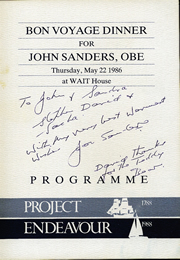
Invitation to Jon Sanders'
official Bon Voyage Dinner,
with a dedication to John Penrose
by Jon Sanders.
Records of Project Endeavour.
Project Endeavour
photograph
album and
scrap book compiled
by
John Penrose, 1986 - 1988.
CUL00040/1.
The First Circumnavigation (25 May 1986 - 29 January 1987)
The first leg of Sanders' voyage was intended to go westward round the Cape of Good Hope, cross the Equator, then go round Cape Horn to Fremantle where the yacht would do a lap of the America's Cup course in 1987. 45 To qualify as a 'true' circumnavigation, according to the Guinness Book of Records, the sailor must go above the Equator for at least 24 hours. Originally, the voyage was scheduled to turn at Cape Verde above the Equator but Sanders' radio mentor Jack Seabrook suggested the turning point be the Islands of St Peter and St Paul as this would save 10,000 nautical miles. 46
A day in the life of a solo sailor included frequent sail changes, repairs, navigation duties, steering, keeping up logbook entries, cooking, cleaning, doing laundry and tending to personal hygiene. As there was no butter, margarine or cooking oil in the stores, Sanders used tomato juice for cooking. By September 1986, the cabin stove was having problems with the pressure gauge leaking and supplies of methylated spirits, which were used for priming, had run out. 47
Engine problems on the Parry Endeavour began from day 50. When Sanders started the motors to recharge his batteries he found them difficult to turn over. Some 68 days in, the engines became even less reliable with water contaminating the fuel. These problems would continue throughout the journey, and Sanders had to complete approximately three quarters of the voyage without his engines, instead relying on solar panels to recharge the batteries. 48
On 31 July 1986 (day 51), the first mail exchange took place in rough and dangerous seas near Cape Town. The Guinness Book of Records rules, as laid out by Squadron Leader D H (Nobby) Clark, allowed Sanders to receive only letters and newspapers. Sanders believed that the manoeuvre to sail the yacht near Cape Town for mail exchanges was too dangerous in winter, and decided against attempting it again on the second and third roundings of the Cape. 49
Rounding Cape Horn in early October 1986, Sanders experienced extreme weather, with 20 metre waves, 75 to 110 km/h winds and near zero temperatures over a twelve hour period. 50
On 11 November 1986 (day 171), the yacht was in radio range of Qantas Flight 11 operating between Sydney and Tahiti. A talk had been arranged between the Captain of the Qantas flight and Sanders on the Parry Endeavour at sea. On this occasion, however, the two had failed to make radio contact. 51 On the 19 December 1986, Sanders maintained contact with Qantas Flight 44 operating between Auckland and Sydney for a period of over 20 minutes and the conversation was recorded and is now available in the Project Endeavour Collection. 52
Sanders recorded scientific data throughout the journey. As he moved westward, he explored the ocean seabed in the Variables, south of Easter Island, with the echo sounder as instructed by John Penrose. On day 188, Sanders tested the Echo Sounder only to discover that the equipment was misreading. On 30 November, the Parry Endeavour sailed over a plateau and for two days Sanders plotted depths with the sounder, observing 'The bottom rose dramatically from 400 fathoms [about 730 metres] to 11 fathoms [180m] and I have no doubt it was a volcano on the ocean bed. Later, I got distinct echoes from a series of mountain peaks in between deep gullies. It was fascinating, because I was probing ocean beds that have never been charted'. 53
When Sanders sailed past Fremantle at the end of the first circumnavigation, these depth-sounding readings were transferred from the Parry Endeavour to a waiting boat from Curtin University of Technology. 54
Sanders had promised his sponsor Kevin Parry that he would sail past the America's Cup course off Fremantle on Thursday 29 January 1987, two days before the final match. He had requested that the Kookaburra's chase boats escort the Parry Endeavour across the Cup course to ensure that no one attempted to board the yacht. Had someone boarded the yacht, it would have disqualifyed his record attempt at a solo, non-stop triple-circumnavigation.
Sanders arrived in Fremantle at approximately 8.30am with two chase boats alongside. He was joined by the Sutherland, Parry's power yacht, which carried media representatives. Sanders had a brief chat at sea with a group of people including Royal Perth Yacht Club Commodore Alan Crewe and Parry officials. Spectator craft included the Royal Perth Yacht Club's Part VI, the Perie Banou skippered by Colin Sanders and the John Curtin which had WA Premier Brian Burke and Curtin Vice-Chancellor Don Watts on board. A crowd of more than 3,000 had assembled to wish Sanders well on the next leg of his voyage. 55
Fremantle Post Officer Frank Reid used a jet-powered chase-boat to deliver three bags of mail to the Parry Endeavour. This mail was vetted by Australia Post, Curtin University, Parry Corporation and Colin Sanders to ensure it did not contain any food or equipment that would help Sanders on his voyage. Although the rules of the Guinness Book of Records allowed the delivery of letters and newspapers, Sanders decided against further mail deliveries in the second and third circumnavigations. 56
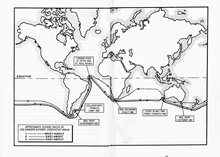
Map showing route of triple circumnavigation from
Schmitt, H. 1988, Sanders - sextant, sea and solitude,
St George Books, pp. 56-57.
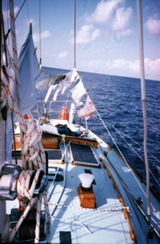
Drying clothes at sea aboard the Parry Endeavour.
Records of Project Endeavour.
At sea, 9 August to 29 Sepember
1986.
CUL00039/19/1.
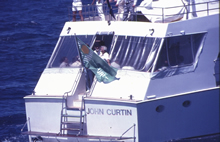
Curtin University Vice-Chancellor
Don Watts aboard the John Curtin, supporting Sanders on the
completion of the first leg,
29 January 1987.
Records of Project Endeavour.
Don Watts aboard the John Curtin,
29 January 1987.
CUL00039/17/49.
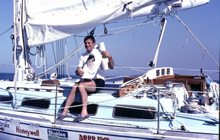
Jon Sanders opening his mail aboard
the Parry Endeavour, 29 January 1987.
Records of Project Endeavour.
Jon Sanders aboard the Parry
Endeavour, 29 January 1987. CUL00039/17/55.
The Second Circumnavigation (29 January 1987 - 14 September 1987)
On the second leg of the triple-circumnavigation, the Parry Endeavour was to go eastward around the Horn, across the Equator, and south of the Cape of Good Hope and the Australian mainland. 57
On 14 March 1987, while on the Parry Endeavour in the South Pacific, Sanders was the guest speaker at a Rotary dinner held on Rottnest Island, answering questions from John Penrose and Colin Sanders through Wellington Radio. 58
Equipment problems continued to plague the voyage. In March 1987, the satellite navigation equipment failed due to problems caused by condensation in the cabin. In place of this equipment, Sanders relied on his sextant and tables for navigation, noting, 'I am navigating without a distance-run or speed log working. But I am used to that. I estimate the speed and multiply by time'. 59Shortly afterwards, all three main HF (long distance) radios played up due to condensation. 60
Additionally, around this time, problems with rust on tins of canned food resulted in leakage and spoilage of canned goods stored in the cabin. Sanders had to throw out most of the cans of tomatoes, spaghetti, baked beans, tinned fish, tinned pineapple and mushroom. To conserve food supplies, Sanders no longer routinely ate lunch every day from this time onwards. 61
On this second lap, Sanders recorded depth soundings that confirmed the discovery of a major seamount, a core objective of the scientific research undertaken on the voyage. 62 On 22 March 1987, Sanders switched on the echo sounder for a test pattern but discovered the sounder was misreading. By 28 March, Sanders had altered course to follow a line drawn on his chart by John Penrose. Shortly after midnight, the sounder was obtaining definite results. The next morning, the equipment retrieved a true echo at 411 fathoms and the soundings indicated that the mountain peak was right on the line Penrose had marked. 63
On 29 April, Sanders sailed around Cape Horn for the second time. The next day the yacht's Servo self-steering rudder had disappeared, with the bolt either working its way off or snapping. Sanders had to fit a new rudder. 64
On 4 May 1987, the Parry Endeavour was in the South Atlantic. Just after 6.30 in the evening, Sanders heard a shriek of steel - the yacht had bounced off a 4,500 tonne Asian squid trawler! In the trawler's arc lights, he saw his jib ballooning away from the yacht, the mast leaning and the bow rail a tangled mess. Fortunately there were no holes visible in the yacht's fibreglass hull. 65 In his logbook, Sanders wrote:
'2035 - AWFUL! Collided with foreign squid boat, about 4000 tons. Broke forestay (starboard), but port forestay appears to be okay. Smashed pulpit. Yacht seems okay. No holes that I can detect. Luck the rigging is so strong. Most upsetting. Wind 20-25 knots NNW - a wind change.'
'Yacht appears to be okay. Balance of broken forestay swinging around from top of mast, will recover in smoother waters. Centre back stay is now loose, must have helped take the shock. Luck the bow is reinforced etc. Pulpit a tangled mess'. 66
Sanders put the yacht back on course with a revised rig. 67
Shortly after the collision with the trawler, HF (long distance) radio contact became unreliable once again due to severe weather conditions which caused corrosion in some of the circuit boards. Sanders could only make contact with his radio mentors by VHF radio as he passed Australia. 68
On 16 July, a screaming squall hit the yacht and capsized it beyond 100 degrees. In yachting terms this is referred to as a 'knockdown' as the mast of the boat is below water level. Sanders' favourite winch handle, buckets and various bits of gear in the cockpit went overboard and lockers in the cabin opened sending food jars crashing and breaking. The wind was at hurricane strength for about half an hour. 69
Two days later, Sanders crossed the zero meridian from West to East longitude, breaking Perie Banou's 1981-82 double circumnavigation record of 419 days, 22 hours, 10 minutes at sea. 70
On 22 July, the Parry Endeavour approached the Cape of Good Hope in non-stop gale conditions. This second rounding of the Cape provided Sanders with the worst weather conditions of his voyage. Over four continuous days the wind velocity did not fall below 35 knots, with winds of mostly 50-60 knots.On the morning of 28 July, Sanders experienced his third knockdown of the storm 71. That afternoon the yacht was knocked down yet again, this time at 90 degrees. In all, the Parry Endeavour was knocked down four times and Sanders was forced to 'heave-to', i.e. face in the wrong direction, in horrific seas for three full days and nights. 72
Approaching the end of the second leg of the voyage, the Parry Endeavour was met by the Portofino off Cape Leeuwin. On board the boat were Richard Stainton and other Perie Banou crew mates hoping to exchange messages with Sanders. Also present was a luxury power cruiser chartered by the Royal Automobile Club's Chief Executive, Roy Caldwell, a friend of Sanders. Caldwell's son, John, had also sailed in the crew of the Perie Banou. On 14 September, an RAAF Orion anti-submarine turbo-prop aircraft circled the yacht with journalist and Sanders biographer Hugh Schmitt on board. 73
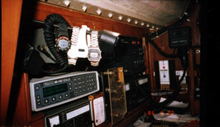
Radio Equipment on the Parry
Endeavour.
Records of Project Endeavour.
At sea, 9 August to 29 Sepember
1986. CUL00039/19/1.
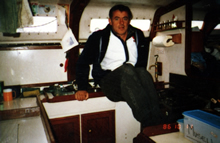
Jon Sanders in the kitchen
area
of the Parry Endeavour's cabin.
Records of Project Endeavour.
At sea, 9 August to 29 Sepember 1986. CUL00039/19/1.

The bow rail, showing damage caused by the collision with
the prawn trawler,
4 May 1987.
Records of Project Endeavour.
Damage caused by collision with
trawler, May 1987. CUL00039/21/2.
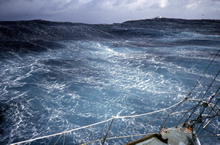
Records of Project Endeavour.
Bad storms and knock-downs,
28 July 1987. CUL00039/18/8.
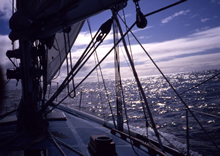
Records of Project Endeavour.
Aboard the Parry Endeavour,
1986 - 1987. CUL00039/18/9.
The Third Circumnavigation (14 September 1987-13 March 1988)
On the third and final leg of his triple circumnavigation of the world, Sanders journeyed around the Horn, across the Equator and into the Indian Ocean. 74
On Guy Fawkes Day, 5 November, dieselene leaked into the bilge and Sanders had to pump diesel out of the starboard tank to a buck and dump it into the sea.
By this time also, Sanders' videocassette recorder had stopped working and he could no longer view the videos he had taken with him on the voyage.
On 28 December the cabin stove stopped making gas and poured out fiery liquid kerosene which filled the cabin with black smoke and stained the roof beams. 75
During this third leg, Sanders experienced a flare up of a chest complaint called pleurodynia, which is exacerbated by damp and cold conditions. This caused Sanders intense pain in the right side of his rib cage. Indeed, Sanders was plagued by ongoing problems with dampness in the cabin. He had an almost non-stop job of scrubbing mould from the inside of the yacht. 76
To keep his voice box exercised, Sanders spoke his thoughts aloud each day. He kept up regular leg and toe stretching exercises, as well as exercising his stomach muscles. He maintained his general fitness by by running on the spot. 77
The Argos system on the yacht carried a transmitter that radiated a code signal at 60 second intervals. The satellite Noah 9 carried the receiver for the Argos system and the signal data was downloaded every few orbits to a computer in Virginia, USA. The data was then sent to Toulouse, France, and from France to the Centre for Marine Science & Technology (CMST) in Bentley, WA. The signal was guaranteed accurate to within three kilometres, but was usually more accurate than this, being reliable to within 100 metres. If Sanders had to abandon ship, he could activate the alarm button on the transmitter platform to alert scientists in Toulouse who would in turn notify the French Coast Guard, CMST and the Sea Safety and Surveillance Centre in Canberra. If the transmitter stopped sending the signal, the CMST would also be notified. 78
At 11.35am on 25 November 1987, the Argos satellite reporting system on the yacht went into distress mode and an alarm was relayed to John Penrose and his assistant, Tim Pauly, at the CMST. At the time, Sanders was off the Falkland Islands. Penrose telephoned the Canberra Sea Safety Centre, Parry Corporation , the Falklands Governor in Port Stanley and the Port Stanley Harbour Master, Captain John Jackson. By 10pm, Penrose was notified that a Royal Navy Sea King Helicopter had made an aerial sighting of Sanders on his yacht and all was well. 79 The false alarm had ceased after 100 minutes and it is still not known what caused the malfunction in the ARGOS system. 80
At 3.15am the next day, the Canberra Centre phoned John Penrose to inform him of another mayday message, calling back some 15 minutes later to report that it was an error. The message was actually from the previous day's false alarm. 81
Sadly, Sanders' mother passed away at age 80 on 17 December 1987. As the HF (long distance) radio was not working, his family were unable to notify him of her death until 9 March 1988, a few days before the end of the voyage. 82
Sanders was originally scheduled to arrive at King George Sound, off Albany, to reprovision then complete his journey to Sydney for the Bicentennial celebrations. 83 However, in keeping with the wishes of Parry Corporation, Curtin University, the Australian Bicentennial Authority and the WA public, the finish line was moved to Fremantle. Captain Roy Marsh from the naval patrol ship HMAS Geraldton met with Sanders just prior to his arrival to outline plans for the welcoming festivities. 84
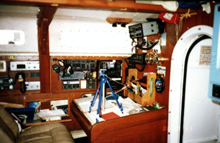
Navigational equipment on the Parry Endeavour.
Records of Project Endeavour.
At sea, 9 to 12 October 1986. CUL00039/19/4.
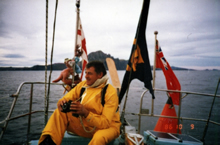
Jon Sanders on board the Parry Endeavour.
Records of Project Endeavour.
At sea, 9 to 12 October 1986. CUL00039/19/4.

Crowds greet Jon Sanders at Fremantle Passenger Terminal on his
return from his 658 day voyage.
Records of Project Endeavour.
Fremantle Passenger Terminal,
March 1988. CUL00039/13/17.
Returning Home
Sanders sailed into Fremantle at 10.17am on Sunday 13 March 1988, completing his triple circumnavigation of the world. The voyage took 658 days and he had travelled 70,000 nautical miles. History records it as the longest, non-stop, solo voyage. 85
The finish line was off the North Mole and former Premier Sir Charles Court fired the finish gun. 86 Marine and Harbour craft escorted Sanders and the Parry Endeavour into Fremantle Harbour. 87
The yacht was dressed in the Bicentennial, Curtin University, RAC, Royal Perth Yacht Club and Australian flags. Sanders had hung a Christ Church Grammar School football jumper on one of the back stays. An estimated 350 craft and 130,000 people were on the sea and shore to greet Sanders. The first people to board the Parry Endeavour were Royal Perth Yacht Club Commodore Ian Cameron and his wife Nola, followed by Customs and Quarantine officials. 88
WA Premier Peter Dowding presented a welcome speech and a parade was held in Sanders' honour throughout Perth streets the following Thursday. This day of the parade was proclaimed 'Jon Sanders Day' by the local newspapers and the State government gave all WA school children the day off school. An advertisement in the morning newspaper asked:
'Jon Sanders made it three times around the world - can you make it to his parade?'.
Sanders sat in the back of a 1947 red MG-TC sports car driven by Royal Perth Yacht Club past Commodore, Noel Semmens. He was escorted by eight mounted policeman. Both the Perie Banou and the Parry Endeavour formed part of the parade. 89
Sanders received many accolades following his amazing journey.
The Guinness Book of Records recognised him as the first person to single-handedly complete five circumnavigations, and as the first person to single-handedly complete three non-stop circumnavigations. The triple-circumnavigation was the longest distance sailed continuously by any vessel (131,535 km). 90
On 21 March 1988, The WA Coastal Shipping Commission renamed the Stateship Baltimore to Jon Sanders, in honour of Sanders' achievements. 91
In April 1988, Curtin University named Sanders as a Curtin University of Technology Fellow.
The Royal Perth Yacht Club created a special gold medallion named the James Cook Award for Sanders in recognition of his 'rare and exceptional feats of seamanship and navigation'. 92
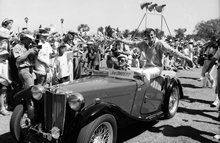
Jon Sanders in a 1947 sports car in the parade held in his honour, 17 March 1988.
Records of West Australian News Ltd.
Welcome home parade for
Jon Sanders,
17 March 1988. CUL00059/15.
Courtesy West Australian Newspapers.
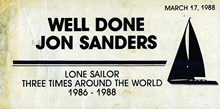
Flag waved by Perth school children
at the parade on 17 March 1988
in honour of Jon Sanders.
Records of Diana Dunbar. Jon Sanders welcome home parade paper flags, 17 March 1988. CUL00064/1.
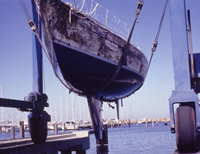
Residual marine growth on hull of
the Parry Endeavour following the
triple circumnavigation, March 1988.
Records of Project Endeavour.
Residual marine growth on hull,
March 1988. CUL00039/13/6.
After all the calms and fickle winds, after all the tempestuous gales - frightening sometimes - after clearing mighty Capes - more than once - after crossing a lot of oceans more than once, after hundreds and hundreds and hundreds of days at sea - 658 in all - you can imagine my moment, you can imagine my hour, when I stood on the cockpit ladder step and looked forward as I have done so often before and there dead ahead of the yacht was the Rottnest Island Lighthouse. Home, once more.
- Jon Sanders, speaking at the official welcome home celebrations, 13 March 1988. 93
 |
|||||||||||